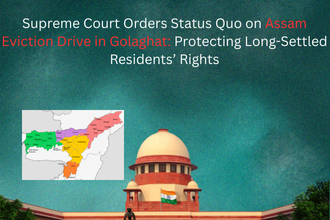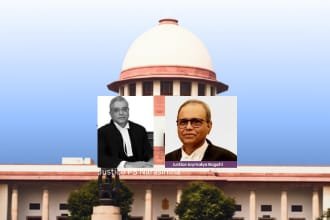On 23 August 2025, the Supreme Court of India ordered status quo on the ongoing eviction and demolition actions in Uriamghat and adjoining villages of Golaghat District, Assam. The order comes as a major relief to villagers facing displacement after eviction notices were issued under the Assam Forest Regulation, 1891.
A bench of Justices PS Narasimha and Atul S Chandurkar issued the directive while hearing a petition challenging the Gauhati High Court’s refusal to grant relief to the affected residents. The apex court’s intervention highlights the delicate balance between forest conservation laws and the fundamental rights of long-settled communities.
Background of the Case
In July 2025, the Assam authorities served eviction notices to villagers of Uriamghat and nearby areas, stating that their settlements fell within the Doyang and South Nambar Reserved Forests. The notices gave residents only seven days to vacate their homes.
Aggrieved by this, the villagers approached the Gauhati High Court, claiming that many of them had been residing there for more than seven decades, with valid recognition from the State such as:
- Electricity connections
- Ration cards
- Inclusion in electoral rolls
- Local infrastructure access
Despite these assertions, a Single Bench of the High Court dismissed their claims, categorizing the residents as trespassers. Their appeals were subsequently rejected, leading them to move the Supreme Court.
Petitioners’ Arguments
The petitioners, represented by Senior Advocates Chander Uday Singh and Rauf Rahim, argued that the eviction drive violated multiple statutory and constitutional safeguards.
1. Violation of Forest Rights Act, 2006
They contended that the authorities had failed to conduct a proper settlement inquiry as required under the Forest Rights Act, 2006 (FRA), which recognizes the rights of forest-dwelling Scheduled Tribes and traditional forest dwellers.
2. Breach of Assam Forest Regulation, 1891
While the eviction notices were issued under the Assam Forest Regulation, 1891, the petitioners claimed the procedure under the law was not properly followed, depriving them of an opportunity to establish long-term habitation rights.
3. Ignoring Land Acquisition & Rehabilitation Laws
The residents also cited violations of the Right to Fair Compensation and Transparency in Land Acquisition, Rehabilitation and Resettlement Act, 2013 and the Assam Rules of 2015, which mandate rehabilitation and compensation before displacement.
4. Fundamental Rights Infringed
The eviction, they argued, undermined their fundamental rights guaranteed under:
- Article 14 (Right to Equality)
- Article 19 (Freedom to reside and settle)
- Article 21 (Right to Life and Livelihood)
- Article 25 (Freedom of Religion, relevant for those with religious sites in villages)
- Article 300-A (Right to Property)
Supreme Court’s Intervention
After hearing preliminary submissions, the Supreme Court ordered status quo, halting any further demolition or eviction activity. The Court also issued notice to the State of Assam seeking its response.
The petitioners relied on the Court’s earlier ruling in In Re: Directions in the matter of demolition of structures, where the Court mandated:
- Prior notice to affected residents
- An opportunity of hearing
- Proper rehabilitation measures before eviction
The current order ensures that no further harm will come to the villagers until the Court fully hears the matter.
Key Legal Issues Raised
The case raises several significant constitutional and legal issues:
- Can long-settled communities be evicted from forest areas without rehabilitation?
- What is the scope of State power under the Assam Forest Regulation, 1891 vis-à-vis the Forest Rights Act, 2006?
- Do electricity, ration cards, and electoral rolls constitute evidence of lawful settlement?
- How should courts balance environmental protection with human habitation and livelihood rights?
Broader Context: Eviction Drives in Assam
Assam has witnessed multiple eviction drives in recent years, particularly in forest and flood-prone areas. Authorities argue that such measures are necessary to preserve biodiversity, prevent encroachment, and protect forest land.
However, critics highlight that many of the so-called encroachers are generations-old settlers, some of whom belong to marginalized communities with no alternative housing or livelihood. The lack of proper rehabilitation plans has led to humanitarian concerns, with reports of families rendered homeless overnight.
Constitutional Balancing: Environment vs. Human Rights
The Supreme Court has historically emphasized sustainable development, where environmental protection must be harmonized with human rights and livelihood security.
- In Olga Tellis v. Bombay Municipal Corporation (1985), the Court held that the right to livelihood is part of Article 21.
- In T.N. Godavarman v. Union of India, the Court took a strong stance on forest conservation, leading to widespread restrictions.
- More recently, the Court has stressed that forced evictions without due process are unconstitutional.
The present case continues this debate, testing how far long-settled residents can claim rights against forest conservation policies.
Possible Implications of the Case
- Strengthening FRA Protections: If the Court recognizes petitioners’ rights, it may reinforce the role of the Forest Rights Act in eviction cases.
- Rehabilitation Norms: The judgment may push States to adopt stricter rehabilitation and resettlement measures before carrying out eviction drives.
- Property and Equality Rights: A ruling favoring residents could expand jurisprudence under Articles 14, 21, and 300-A.
- Future Eviction Policies: The case may serve as a precedent for eviction drives across India, ensuring human rights safeguards in forest governance.
Conclusion
The Supreme Court’s order to maintain status quo on the eviction drive in Assam’s Golaghat is not just a temporary relief—it is a crucial intervention that could reshape the legal landscape of eviction, rehabilitation, and forest rights in India.
At its core, the dispute is not just about land and forests, but about people, their history, and their dignity. The final outcome of Abdul Khalek & Ors. v. State of Assam & Ors. (SLP(C) No. 23647-23648/2025) will determine whether the law can truly balance environmental preservation with social justice.
Also Read
Himachal Pradesh High Court: Saying ‘Pakistan Zindabad’ Is Not Sedition Unless India Is Denounced
Supreme Court Clarifies Scope of Section 195 CrPC: No Splitting of Offences to Bypass Safeguards



